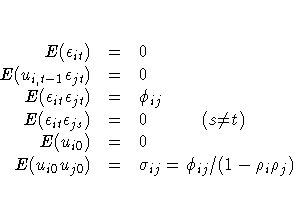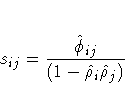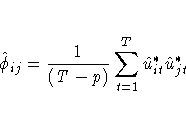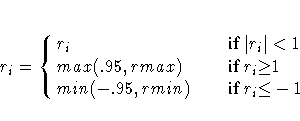Chapter Contents
Previous
Next
|
Chapter Contents |
Previous |
Next |
| The TSCSREG Procedure |
Parks (1967) considered the first-order autoregressive model in which the random errors uit , i = 1, 2, ... , N, t = 1, 2, ... , T, have the structure


The model assumed is first-order autoregressive with contemporaneous correlation between cross sections. In this model, the covariance matrix for the vector of random errors u can be expressed as
![E( {uu}^{'})=V=
[\matrix{
{\sigma}_{11}P_{11} & {\sigma}_{12}P_{12}
& { ... }...
...ma}_{N1}P_{N1} & {\sigma}_{N2}P_{N2} & { ... } & {\sigma}_{NN}P_{NN} \cr
}
]](images/tsceq78.gif)
where
![P_{ij}=
[\matrix{
1 & {\rho}_{j} & {\rho}_{j}^2 & { ... } & {\rho}^{T-1}_{j} \...
...{\rho}^{T-1}_{i} & {\rho}^{T-2}_{i} & {\rho}^{T-3}_{i} & { ... } & 1 \cr
}
]](images/tsceq79.gif)
The matrix V is estimated by a two-stage procedure,
and ![]() is then estimated by generalized least squares.
The first step in estimating V involves the use of
ordinary least squares to estimate
is then estimated by generalized least squares.
The first step in estimating V involves the use of
ordinary least squares to estimate ![]() and
obtain the fitted residuals, as follows:
and
obtain the fitted residuals, as follows:

A consistent estimator of the first-order autoregressive parameter is then obtained in the usual manner, as follows:

Finally, the autoregressive characteristic of the data can be removed (asymptotically) by the usual transformation of taking weighted differences. That is, for i = 1,2, ... ,N,


which is written

Notice that the transformed model has not lost any observations (Seely and Zyskind 1971).
The second step in estimating the covariance matrix V is to apply ordinary least squares to the preceding transformed model, obtaining

from which the consistent estimator of ![]() ij is calculated:
ij is calculated:

where

EGLS then proceeds in the usual manner,

where ![]() is the derived consistent estimator of
V. For computational purposes, it should be pointed out that
is the derived consistent estimator of
V. For computational purposes, it should be pointed out that
![]() is obtained directly from
the transformed model,
is obtained directly from
the transformed model,

where ![]() .
.
The preceding procedure is equivalent to Zellner's two-stage methodology applied to the transformed model (Zellner 1962). Parks demonstrates that his estimator is consistent and asymptotically, normally distributed with


where
![rmax = \cases{
0 & \hspace*{1em}\rm{if} r_{i} \lt 0\space \rm{or} r_{i}{\ge}1
...
...s_{j}
[ r_{j} : 0 {\le} r_{j} \lt 1 ]
& \hspace*{1em}\rm{otherwise} \cr
}](images/tsceq98.gif)
and
![rmin = \cases{
0 & \hspace*{1em}\rm{if} r_{i} \gt 0\space \rm{or} r_{i}{\le}-1...
...s_{j}
[ r_{j} : -1 \lt r_{j} {\le} 0 ]
&\hspace*{1em}\rm{otherwise} \cr
}](images/tsceq99.gif)
Whenever this correction is made, a warning message is printed.
|
Chapter Contents |
Previous |
Next |
Top |
Copyright © 1999 by SAS Institute Inc., Cary, NC, USA. All rights reserved.